Automatic rifle M231 Firing Port Weapon (USA)
The project of a new automatic rifle, which has a distinctive appearance, was originally part of a larger program to develop new weapons and equipment. In the mid-sixties, the Pentagon launched the Mechanized Infantry Combat Vehicle program, the purpose of which was to create a promising armored vehicle for transporting soldiers with weapons. The end result of this program was the M2 Bradley infantry combat vehicle, which went into series and became widespread. Together with the armored vehicles under the MICV program, some other new products should have been created. In particular, the military demanded the development of special small arms.
The MICV program’s technical assignment stipulated the use of airborne embrasures of the troop compartment, with which the soldiers could fire at the enemy from their personal weapons, while remaining protected by armor. However, it soon became clear that regular M16 rifles cannot be used for such purposes. An unacceptably long rifle could not ensure the proper comfort of the soldiers. Moreover, in some cases, the shooter would not even have the opportunity to insert his weapon into the embrasure due to problems with his ergonomics. It became clear that for equipping onboard embrasures, some new weapon with high firing characteristics and acceptable dimensions is required.
In 1972, the Rhode Island Arsenal received a new mission. Using existing products and developments, Arsenal specialists had to create a promising model of small arms, fully compatible with the embrasures of the new BMP. The main objective of the project was the development of weapons with certain dimensions. In addition, the new model was to differ from the existing ones by some increase in firepower. The project of advanced weapons for armored vehicles received the designation Firing Port Weapon - “Weapons for firing through the loopholes”.
Soon, Rock Island gunsmiths came up with three options for the new weapon. The first preliminary draft suggested the use of a heavily redesigned M3 submachine gun from World War II. The second project involved the use of a converted Heckler & Koch HK33 automatic rifle. The third and final proposal involved the creation of a new weapon based on the standard M16 army rifle with a significant redesign of its design.
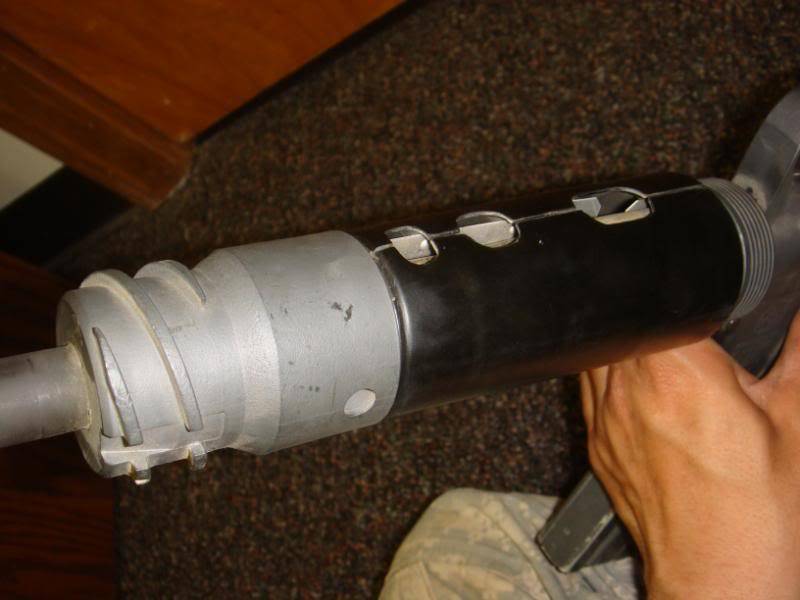
Handguard, adapted for use with an embrasure BMP. Photo Augee / Ar15.com
For some time, parallel development of three projects has been carried out. In 1974, the customer compared the available offers and made his decision. On the basis of the calculated characteristics, the third project was the most successful, based on the M16 automatic rifle design. It was decided to continue work on this project while closing the other two. The remaining project received a new working designation XM231.
It should be noted that the XM231 project was only based on the ideas and aggregates of an existing automatic rifle. The requirements of the military to the FPW product, related to the improvement of the main characteristics, as well as the specifics of the use of such weapons led to the appearance of noticeable differences. In particular, the characteristic feature of the new rifle was to become a different “heavy” barrel, with the help of which it was planned to ensure the possibility of long-term shooting at a higher rate. In addition, in order to increase the rate of fire automation has undergone notable differences. The design changes used suggest that, unlike the basic M16 product, the new XM231 was not an automatic rifle, but a light machine gun.
Numerous refinements of the original design clearly affected the timing of the project. By the mid-seventies, the product XM231 was able to bring to the test, but the test and the subsequent refinement took a lot of time. During the finalization of the project, it was decided to abandon the previously proposed shoulder rest, change the means of fastening the rifle in the embrasure, and also reduce the rate of fire. The first two changes were related to the safety of the shooter: during the tests, it became clear that the rifle could fly off with insufficiently strong mounts and injure the fighter with the butt. The requirement to reduce the rate of fire, in turn, was caused by the need to save ammunition and defeat targets. With the current rate of fire, a fighter could devastate a shop in seconds without any special results.
All the necessary work to improve weapons continued almost until the very end of the decade. Only in 1979, the prospective weapon was declared ready for use and recommended for use. The automatic rifle was standardized under the designation M231 Firing Port Weapon.
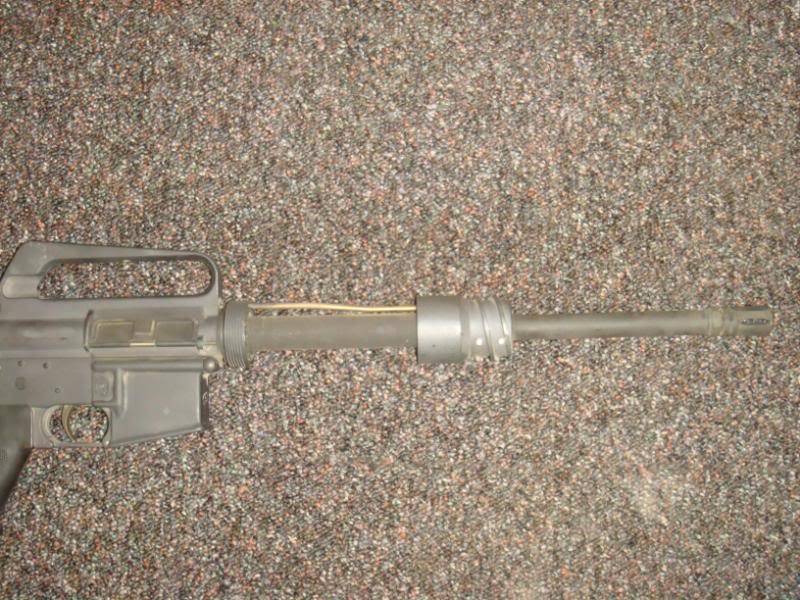
Rifle without forearm. Photo Augee / Ar15.com
From the point of view of some basic features of the design, the new model was a direct development of the existing M16 rifle. The already tested layout with a receiver box divided into two “receivers”, gas automatics with a piston mounted on a slide frame, etc. were used. At the same time, an updated design of the firing mechanism, advanced fire control devices and new elements for interaction with embrasure were used. Externally, the new M231 rifle looked like a serial M16, which received a new forearm and lost its stock. The degree of unification was 65%.
The main element of the design of the rifle for the BMP, as in the case of the base model, was a metal receiver, divided into two articulated devices. The upper part of the box had a cylindrical internal channel with several additional slots, stops and windows necessary for the installation of the bolt group. The lower "receiver" had a store front shaft, and in its rear part were placed the details of the firing mechanism. In addition, this element of the receiver had a ring to install a cylindrical recoil spring, taken out of the weapon.
The product M231 FPW received a rifled barrel caliber 5,56 mm, which is a modified unit of the basic rifle. Because of the need for long firing, the barrel of a new weapon was distinguished by a greater wall thickness. It was originally proposed to use a barrel with a length of 280 mm (50 gauges), but during the refinement of the weapon, this parameter was increased to 396 mm (71 caliber). The barrel was equipped with a slot-type flame arrester borrowed from the M16. In the middle part of the barrel there was a gas outlet, through which the powder gases were supplied to the piston. As in the case of the base sample, a gas tube of small cross section was installed between two large bushings placed on the central and breech parts of the barrel. The front hub received a spiral protrusion necessary for proper interaction with the BMP embrasure.
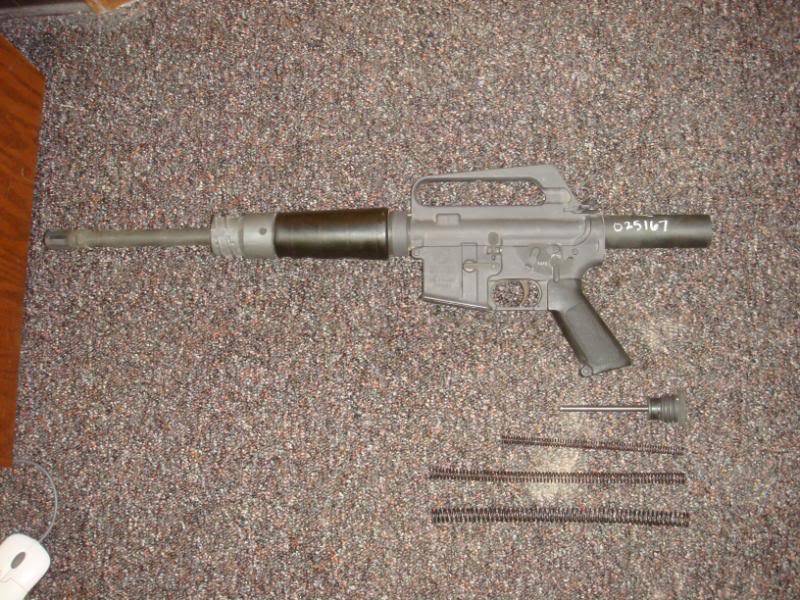
The return and buffer springs are removed. Photo Augee / Ar15.com
For the M231 rifle a new shank was developed. It consisted of two symmetrical halves and could be removed from the weapon. Handguard had metal parts, trays, interacting with the sleeves of the trunk. Plastic covers were mounted on top of these devices. This handguard differed from the standard with a smaller length and dimensions that meet the new requirements of the customer.
New rifle retained the existing design of the bolt group. Its main element was a massive frame moving in the cavity of the receiver. At its front end there was a slot for the installation of a butterfly valve. Above, it was planned to install a short gas piston that does not extend beyond the bounds of the receiver. The barrel was locked by turning the bolt with several lugs.
The structure of automation initially included only one return spring, located behind the bolt group, in the receiver and the rear casing. Calculations and tests have shown that with this design the rifle can show technical rate of fire more than 1220 shots per minute. Such characteristics were considered redundant for the intended method of application, because of which the project was finalized. Two additional buffer were placed on a common guide rod with a return spring. Increasing the rollback time, it was possible to reduce the rate of fire to acceptable values.
The most important feature of the M231 Firing Port Weapon product was shooting from the open bolt. Before firing, the slide group was retracted and fixed there with a sear. She moved forward only after pressing the trigger. Such a refinement of automation allowed to improve the cooling of parts, but demanded the use of a redesigned firing mechanism. So, the place of the trigger took a sear that blocks the shutter. The design of the automatic fuse-translator of fire has changed accordingly.
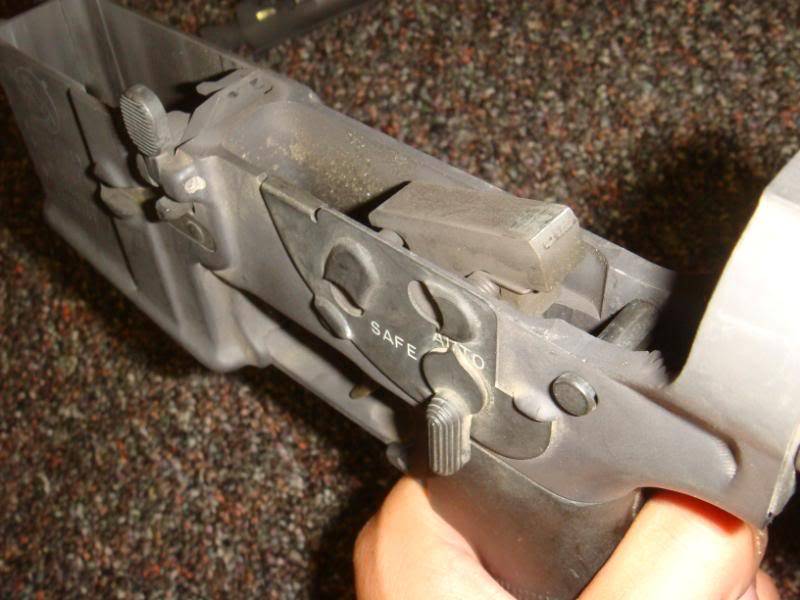
Details of the firing mechanism. Photo Augee / Ar15.com
Unlike the base rifle, the new M231 could only fire in bursts. The choice of such a shooting mode or blocking the trigger was carried out using a standard flag on the left surface of the weapon. It is noteworthy that the small flag was supplemented with a large plate with holes. The latter was intended to protect the pins of fastening parts USM from external influences.
The rifle for the BMP was supposed to use an intermediate cartridge 5,56x45 mm NATO. The ammunition was supplied from a standard 30 magazine with ammo capacity. Cartridges were removed from the weapon through a window in the right wall of the receiver. As with the M16, the ejection window was covered with a movable lid. The rifle was offered to be completed with a fabric bag for collecting spent cartridges.
The specificity of the intended use has affected some of the design features. So, the new rifle did not get the usual sights. The upper carrying handle remained, but there was no movable adjustable rear sight on it. Removed and stand with the front sight on the trunk. For a very rough aiming, the upper U-shaped tray of the handle could be used as a sight. In addition, it was recommended to use only tracer cartridges for tracking the results of shooting with a new rifle. Apparently, the authors of the project considered that the shooter would not be able to realize all the advantages of a conventional sight when firing from a moving armored vehicle.
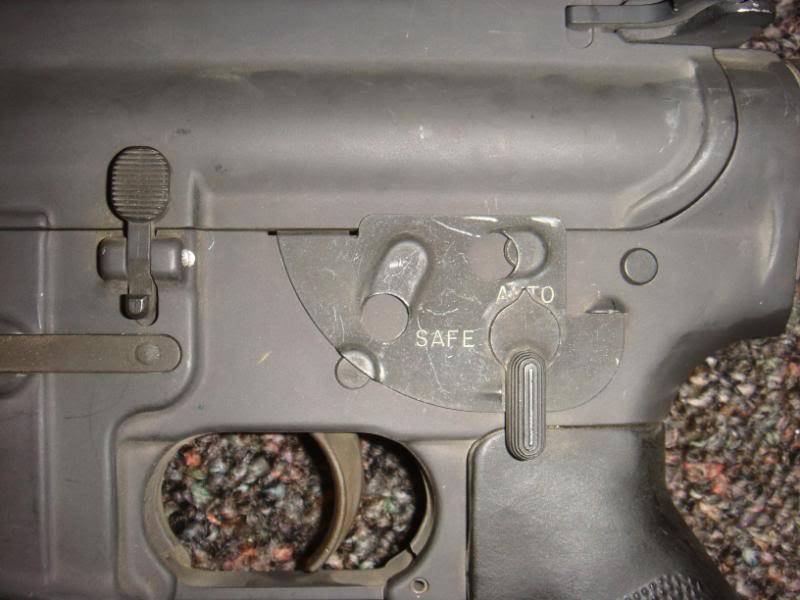
Flap fuse-translator flag. Photo Augee / Ar15.com
One of the reasons for the rejection of the M16 rifle as a weapon for firing from onboard embrasures was its long length, directly related to the use of a rigid butt. For this reason, the M231 butt has not received. From the receiver came out a cylindrical casing return spring, but it was not installed any butts or other products. At the same time, a number of serial rifles for infantry fighting vehicles received simple wire shoulder stops, mounted directly on the rear end of the spring case.
With the 396-mm barrel, the M231 Firing Port Weapon rifle had a total length of 717 mm — nearly a foot shorter than the earlier versions of the M16. The mass of weapons without a magazine was 3,33 kg. A regular magazine on 30 cartridges added 460 to the weight. The technical rate of fire reached 1220 rounds per minute, but was reduced to 200-300 rounds using buffer springs. In a combat situation, the practical rate of fire should not exceed 50-60 rounds per minute. The effective firing range was set at 300 m.
"Weapons for firing through the embrasure" was put into service in 1979 year, shortly before the start of mass production of the newest BMP M2 Bradley. An order for the mass production of new weapons was received by Colt, a little earlier joining the project as one of the developers. Soon the army received the first M231 serial products, which were later introduced into the armored vehicles complex. The design of the "Bradley" machines included the installation of two embrasures on each side of the troop compartment and two similar devices in the rear sheet and the door. Thus, each BMP could carry and use up to six rifles of a new type.
In the late eighties, the production of the upgraded infantry fighting vehicle M2A2 started. It differed from the base sample by a number of changes, including new side screens. The presence of these products overlapped the embrasures of the troop compartment and excluded the use of small arms. Later versions of the M2 Bradley also lost the ability to fire through the onboard embrasures. However, the M231 rifles were not excluded from the weapon system. Now such weapons are transported in the packing of the troop compartment and can be used under certain circumstances. Regular use, however, is no longer foreseen for objective reasons.
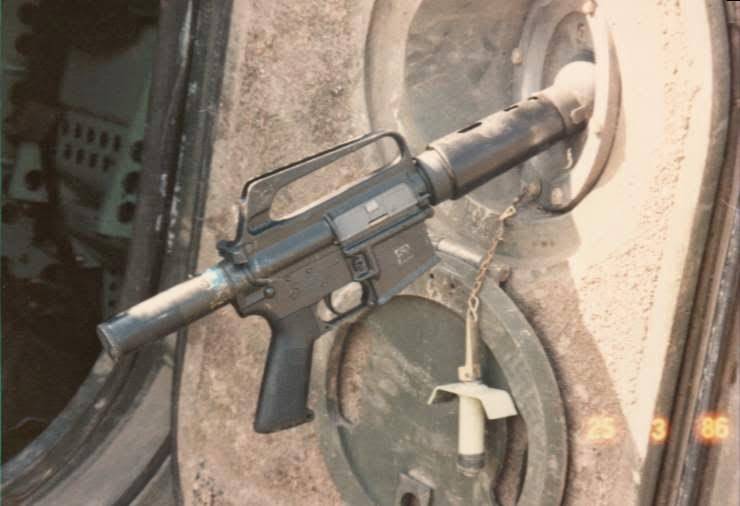
M231 rifle in the rear door embrasure of the M2 Bradley BMP. Photo Chainlinkandconcrete.blogspot.fr
When developing the M231 Firing Port Weapon project, a number of specific requirements were taken into account, directly related to the need to fire through the embrasure. Because of this, such a rifle has some features that seriously distinguish it from the base M16. The M231 product has a greater muzzle flash and other recoil parameters. Handguards special design can be very hot when shooting, and the absence of the usual butt makes it difficult to hold. Finally, the rifle needs a bag-catcher bag. With all the restrictions and rules of treatment, weapons can be used as a conventional automatic rifle outside the armored vehicle.
Officially, the special M231 Firing Port Weapon rifle is still in service with the US Army and remains part of the armament of an infantry fighting vehicle. However, due to the gradual modernization of the fleet of vehicles and the introduction of on-board screens that block the embrasures of the troop compartment, the number of actively used weapons was reduced. To date, the original model has the status of exclusively auxiliary weapons, necessary for the most extreme case. Full operation in the original quality, for obvious reasons, stopped and is unlikely to ever resume.
The M231 automatic rifle project is of particular interest in the context of the development of small arms. The reason for his appearance were some of the shortcomings of the existing rifle systems, namely, the excessive length of regular army rifles. This problem was solved by creating a new model based on the existing structure, but having a lot of differences. The emergence of a new specialized rifle allowed to close the existing niche for the next few years, until its disappearance, due to the further development of armored fighting vehicles.
On the materials of the sites:
http://militaryfactory.com/
http://ar15.com/
http://chainlinkandconcrete.blogspot.fr/
Detailed photo review rifle:
http://ar15.com/forums/t_3_123/459672_M231_Firing_Port_Weapon_Review________56K_MASSACRE______________.html
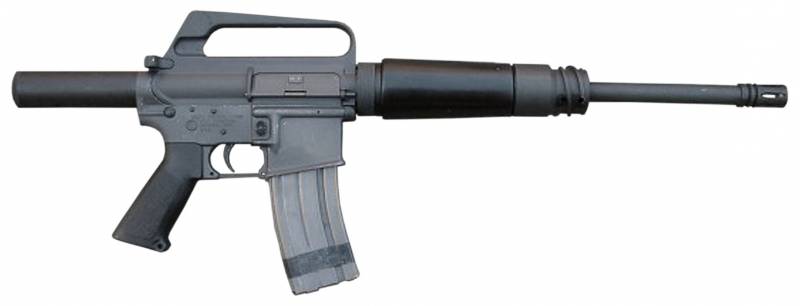
Information